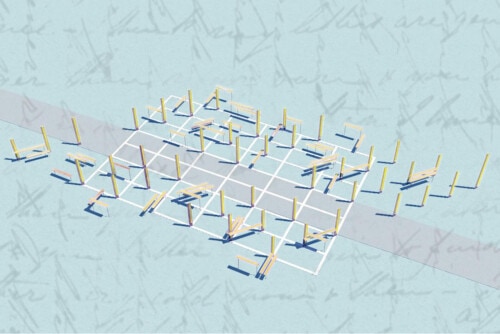III. Copropower: Governmentalities of Shit
Gay men and their poop-obsessed detractors aren’t the only ones to grapple with copropower as a collective corporeal politics of poop. Excrement also figures into increasingly visible controversies about the treatment of prisoners. Globally, debates about imprisonment use feces to viscerally communicate the consequences of mass incarceration. Photos of overcrowded prisons show prisoners crammed like sardines into bathroom stalls, huddled alongside filthy toilets. For those whose political agencies are constrained, excrement becomes a weapon that they can use to reassert their humanity against the instrumentalization of control societies, or that, more often, can be used against them.
In carceral spaces, pooping is a rhythmic event always subject to the panoptic gaze. Unlike the throne at home that so many enjoy in the West, the rest, including prison populations (nearly two and a half million and counting in the United States), do not possess the right to excremental privacy. But the shame associated with having to do one’s private business in public is only one part of an array of techniques of humiliation leveled against prisoners.
Excrement operates as a sign of and is used to induce degradation. Globally, anti-prison activists point to how overcrowding has led to prisoners sleeping in toilets and to cases in which prisoners in solitary confinement have been forced to live with their own excrement for weeks or months. Shit’s appearance in anti-prison discourse also operates as a sign of madness, the insanity that is either caused or exacerbated by prison life and especially the use of solitary confinement, which has been identified as excessive and dangerous even by some within the prison–industrial complex.
Texas, home to a boom prison economy that incarcerates more people than several world nations combined, saw its prison population increase more than 500 percent between 1980 and 2004.1 But even in the Lone Star State, prison life has come under increased scrutiny. Ruiz v. Johnson, a 1999 Texas case that followed an earlier ruling in the 1970s, found that “the extreme deprivations and repressive conditions of confinement of Texas’ administrative segregation units… have been found to violate the Constitution of the United States’ prohibition against cruel and unusual punishment.” Shit appears in the case as evidence of the barbarous conditions of imprisonment and the abnormal behaviors such conditions produce. Shit is mobilized to horrify the public, to communicate the ethic that not even criminals deserve to live in their own waste.
“Shit Boy” emerged as an especially disturbing figure in the torture and abuse of prisoners at Abu Ghraib prison in Iraq. His Christ-like pose echoed those of other prisoners at the prison,2 but his abjection was made yet more visible by the fact that he was covered in his own excrement. American soldiers playfully experimented with ways to restrain him from engaging in self-abuse while filming him from different angles as, bound, he slammed his head against a metal door.3
Anti-prison activists use examples like Shit Boy to argue that the effects of incarceration, and especially the widespread and still-growing use of solitary confinement, contribute to or exacerbate mental illness. Human Rights Watch’s 2003 report “Ill-Equipped” focuses specifically on mental illness in US prisons, noting that a significant number of prisoners suffer from mental illness, with more than seventy thousand “psychotic on any given day.”4 The report underscores the ways the US has effectively criminalized mental illness insofar as underlying psychological factors are ignored in criminal processing; most mentally ill prisoners go untreated. Shit appears throughout the report as evidence of prisoners’ existing mental illnesses or their deteriorating psychiatric conditions. Prisoners smear themselves and their cells with waste and throw it at guards. Sometimes they eat it.
Smearing oneself or one’s cell with excrement might be a sign of the madness that comes from torturous isolation. But shit can also be employed tactically. In the “Dirty Protests” by Irish prisoners during the 1970s and 1980s, for example, prisoners refused to wash, or covered their bodies with excrement, in order to keep from being beaten by guards, though their filth did not in fact always protect them.5 In the US, such behaviors have been criminalized. “Gassing,” prison slang for throwing shit or other bodily matter, is a felony in most states. Thus, a mentally ill prisoner held in solitary who manages to transfer some of his waste onto a guard might be punished yet more severely or have his prison term lengthened.6 When thrown at or otherwise transferred to representatives of the state, excrement is not a sign of abuse, madness, or resistance, but assault. Prisoners’ bodies are not their own, and to assert their autonomy over what is inside their bodies is to challenge the forms of control to which they are subject. This goes some way toward explaining or understanding how some juridical powers see shit not as a sign of insanity or that things have gone too far but as a form of violence, political or otherwise. During the height of the Occupy encampments in 2011, for example, some city officials used the real or imagined presence of human waste at the camps to justify their forcible closure.7
The biopolitical management of shit in prisons not only seeks to delineate the contours around which shit is apprehended—as a dangerous form of bodily contact, as resistance, as madness—but also situates human waste in relation to enterprise and commodification. Mass incarceration is big business. Prison toilets, for instance, have generated an entire industry. No padded toilet seats or cover cozies here. The toilets are stainless steel, utilitarian, instrumental. Albert Sterling & Associates, Inc., for example, offers “high-security and vandal-resistant fixtures for correctional facilities.”8 At Albert Sterling, one can find Americans with Disabilities Act–compliant toilets for disabled prisoners and suicide resistant lav-toilet combos and drinking fountains. The BPH Hemispheric is a “drinking bubbler” “designed to prevent use as a suicide device. Additionally, the bubbler design inhibits its use as a device to dislocate and remove handcuffs.”9 In Sweden, Jets Sanitary Systems promote their “made to please” vacuum flush toilets as being easy to install, sanitary, and environmentally friendly alternatives to traditional gravity toilets.10 These toilets are also advertised for their ability to prevent inmates from passing messages to one another or from intentionally blocking the toilets.
While the prison industry proliferates these specialty copropower toilets, war zones and disasters manifest a slew of improvised commodes, from buckets and humble holes to the ground itself. The pamphlet “A Sewer Catastrophe Companion” outlines basic do-it-yourself waste management based on permaculture designs taught to communities in Haiti and New Zealand following recent earthquakes.11 The guide offers tips on sequestering urine and poop in separate buckets, how much to expect, and how to compost human waste to eliminate parasite eggs (such as roundworm). In Christchurch, New Zealand, permaculture emergency response with alternative toiletry took hold to some degree as the crisis subsided. Gary Williams found that “the dislocation and on-going experience of inadequate services and the lack of the usual amenities of modern life, opens up opportunities for different thinking and unusual or uncommon alternatives.”12 Out of “crisis ordinariness”13 new poop habits can form, including symbiotic partnerships with nonhumans that just love to eat poo.
- Adam Liptak, “1 in 100 U.S. Adults Behind Bars, New Study Says,” The New York Times, February 28, 2008; Eric Nicholson, “Texas Eclipses California as State with Largest Prison Population,” Dallas Observer, August 15, 2012. [↩]
- W. J. T. Mitchell, Cloning Terror: The War of Images, 9/11 to the Present (Chicago: University of Chicago Press, 2011). [↩]
- These images were not released in the American media and it takes some digging to find them. The Australian investigative news program Dateline broadcast them in 2006. Reporter Olivia Rousset’s voiceover accompanies still and video images of Shit Boy—in some posing and smiling with soldiers who have bound him and, in one video clip, slamming his head into a metal door. [↩]
- Human Rights Watch, “Ill-Equipped: U.S. Prisons and Offenders with Mental Illness” (New York: Human Rights Watch, 2003). [↩]
- Begoña Aretxaga, “Dirty Protest: Symbolic Overdetermination and Gender in Northern Ireland Ethnic Violence,” Ethos 23, no. 2 (1995): 123–148. [↩]
- E.g., California Penal Code 4500-4504. [↩]
- Brad Kava, “Occupiers Say ‘Sentinel’ Report on Human Feces Is Full of It,” Santa Cruz Patch, November 21, 2011; Jason Hoppin and Stephen Baxter, “200 Pounds of Human Waste Removed Near Occupy Camp,” Fox News, November 21, 2011. [↩]
- “Prison Fixtures,” Albert Sterling & Associates website. [↩]
- “Penal-Ware Options 1,” Albert Sterling & Associates website. [↩]
- “Vacuum Toilets in Prisons,” Jets Sanitary Systems website (2014). [↩]
- Molly Danielsson and Mathew Lippincott, eds., “A Sewer Catastrophe Companion: Dry Toilets for Wet Disasters,” available through Scribd.com. [↩]
- Gary Williams, “Christchurch Earthquakes—Compost Toilets,” Waterscape: Permaculture Farmstay website, September 21, 2011. [↩]
- Berlant, “Intuitionists: History and the Affective Event,” American Literary History 20, no. 4 (2008): 845–860. [↩]




